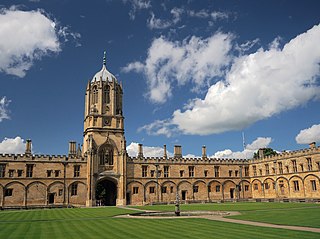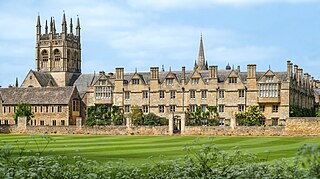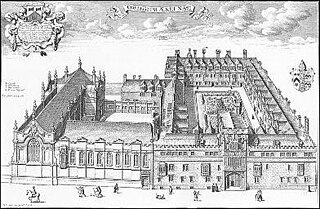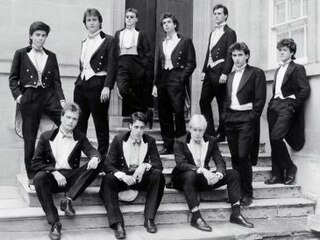Related Research Articles

Black tie is a semi-formal Western dress code for evening events, originating in British and North American conventions for attire in the 19th century. In British English, the dress code is often referred to synecdochically by its principal element for men, the dinner suit or dinner jacket. In American English, the equivalent term tuxedo is common. The dinner suit is a black, midnight blue or white two- or three-piece suit, distinguished by satin or grosgrain jacket lapels and similar stripes along the outseam of the trousers. It is worn with a white dress shirt with standing or turndown collar and link cuffs, a black bow tie, typically an evening waistcoat or a cummerbund, and black patent leather dress shoes or court pumps. Accessories may include a semi-formal homburg, bowler, or boater hat. For women, an evening gown or other fashionable evening attire may be worn.
In Greek mythology, the Myrmidons were an ancient Thessalian Greek tribe.

Christ Church is a constituent college of the University of Oxford in England. Founded in 1546 by King Henry VIII, the college is uniquely a joint foundation of the university and the cathedral of the Oxford diocese, Christ Church Cathedral, which also serves as the college chapel and whose dean is ex officio the college head.

Merton College is one of the constituent colleges of the University of Oxford in England. Its foundation can be traced back to the 1260s when Walter de Merton, chancellor to Henry III and later to Edward I, first drew up statutes for an independent academic community and established endowments to support it. An important feature of de Merton's foundation was that this "college" was to be self-governing and the endowments were directly vested in the Warden and Fellows.

St Anne's College is a constituent college of the University of Oxford in England. It was founded in 1879 and gained full college status in 1959. Originally a women's college, it has admitted men since 1979. It has some 450 undergraduate and 200 graduate students and retains an original aim of allowing women of any financial background to study at Oxford. It still has a student base with a higher than average proportion of female students. The college stands between Woodstock and Banbury roads, next to the University Parks. In April 2017, Helen King, a retired Metropolitan Police Assistant Commissioner, took over as Principal from Tim Gardam. Former members include Danny Alexander, Edwina Currie, Ruth Deech, Helen Fielding, William MacAskill, Amanda Pritchard, Simon Rattle, Tina Brown, Mr Hudson and Victor Ubogu.

White tie, also called full evening dress or a dress suit, is the most formal evening Western dress code. For men, it consists of a black tail coat worn over a white dress shirt with a starched or pique bib, white piqué waistcoat and the white bow tie worn around a standing wing collar. Mid or high-waisted black trousers with galon, a braid of trim consisting of two silk stripes to conceal the outer seams of the trousers, along with court shoes complete the outfit. Orders, decorations and medals may be worn. Acceptable accessories include a black top hat, white gloves, a white scarf, a pocket watch, a white pocket square, and a boutonnière. Women wear full-length ball or evening gowns with evening gloves and, optionally, tiaras, jewellery, and a small handbag.

The University of Oxford has thirty-nine colleges, and four permanent private halls (PPHs) of religious foundation. Colleges and PPHs are autonomous self-governing corporations within the university. These colleges are not only houses of residence, but have substantial responsibility for teaching undergraduate students. Generally tutorials and classes are the responsibility of colleges, while lectures, examinations, laboratories, and the central library are run by the university. Students normally have most of their tutorials in their own college, but often have a couple of modules taught at other colleges or even at faculties and departments. Most colleges take both graduates and undergraduates, but several are for graduates only.
A tailcoat is a knee-length coat characterised by a rear section of the skirt, with the front of the skirt cut away.

Formal wear or full dress is the Western dress code category applicable for the most formal occasions, such as weddings, christenings, confirmations, funerals, Easter and Christmas traditions, in addition to certain state dinners, audiences, balls, and horse racing events. Generally permitted other alternatives, though, are the most formal versions of ceremonial dresses, full dress uniforms, religious clothing, national costumes, and most rarely frock coats. In addition, formal wear is often instructed to be worn with official full size orders and medals.

The Oxford University Parks, commonly referred to locally as the University Parks, or just The Parks, is a large parkland area slightly northeast of the city centre in Oxford, England. The park is bounded to the east by the River Cherwell, though a small plot of land called Mesopotamia sits between the upper and lower levels of the river. To the north of the parks is Norham Gardens and Lady Margaret Hall, to the west the Parks Road, and the Science Area on South Parks Road to the south. The park is open to the public during the day, and has gardens, large sports fields, and exotic plants. It includes a cricket ground used by Oxford University Cricket Club.

Mess dress uniform is the most formal type of evening-wear uniform used by military personnel, police personnel, and other uniformed services members. It frequently consists of a mess jacket, trousers, white dress shirt and a black bow tie, along with orders and medals insignia. Design may depend on regiment or service branch, e.g. army, navy, air force, marines, etc. In modern Western dress codes, mess dress uniform is the supplementary alternative equivalent to the civilian black tie for evening wear. Mess dress uniforms are typically less formal than full dress uniform, but more formal than service dress uniform.

A May Ball is a ball at the end of the academic year that takes place at any of the colleges of the University of Cambridge. They are elaborate and lavish formal affairs, requiring black tie or sometimes white tie, with ticket prices ranging from around £100 to as much as £640 for a pair of dining tickets at Trinity. May Ball budgets can exceed £200,000; a report by the student newspaper Varsity in 2016 found that the budget for the 2015 Trinity ball was £286,000. The balls are held in the colleges, starting around from 6-9 p.m. and lasting until well after dawn. "Survivors photographs" are taken of those who last until morning. Other colleges frequently hold winter balls, such as the popular Selwyn Snowball, who recently had acts such Tinchy Stryder and Mumford and Sons headlining.

The Bullingdon Club is a private all-male dining club for Oxford University students. It is known for its wealthy members, grand banquets, and bad behaviour, including vandalism of restaurants and students' rooms. The club selects its members not only on the grounds of wealth and willingness to participate but also by reference to their education.
The Myrmidon Club is a dining club elected from the members of Merton College, Oxford, and with a continuous history exceeding 150 years. Until recently, the club was single-sex, and an equivalent club for women, named the Myrmaids, was established following the college's decision to admit women students in 1980. It is now a mixed-gender society.
The Gridiron Club, popularly called The Grid, is a private members' club open to male and female students at the University of Oxford.
The King Charles Club (KCC) is a dining society which recruits members exclusively from amongst St John's College, Oxford students.

The Oxford University Polo Club is the Discretionary Full Blue sports club for competitive polo at Oxford University. Founded in 1874, it is one of the four oldest continuing polo clubs worldwide. Its annual Varsity Match against Cambridge University Polo Club, established in 1878, is the second oldest continuing polo fixture in the Western world. It is played at Guards Polo Club, England, usually at the beginning of June.
The PythicClub was a private students' dining club at Oxford University, formerly based in Christ Church. The club was historically associated with Christ Church and it selected its members from the college pool. It is no longer an official college society.

The Night Climbers of Oxford is a secret society, dedicated to nocturnally scaling college and town buildings in Oxford, England. The society is noted for its political activism, controversial acts, feats of climbing and parkour, as well as urban exploration. The society was likely inspired by their Cambridge counterparts, The Night Climbers of Cambridge. Activities conducted by the society are forbidden by the University authorities, meaning that acts are completed under the cover of darkness, to avoid detection.

In 1987, a photograph was taken of uniformed members of the Bullingdon Club featuring many people who went on to hold prominent positions in finance, business, media and government, including future Prime Ministers David Cameron and Boris Johnson. The Bullingdon Club is an all-male private dining club for Oxford University students known for its wealthy membership and unruly behaviour. The image was published in the UK media in 2007 and bolstered criticism of Cameron, who at the time was Leader of the Opposition, for being elitist and out of touch with ordinary people. The copyright holders of the photograph then withdrew permission for the image to be reproduced, which greatly reduced its circulation. Despite this, attempts to broadcast the image have still been made such as the commissioning of a painting of the photograph by the BBC and the photograph being displayed on the front page of the Daily Mirror in 2010. Other photographs of the Bullingdon Club featuring senior Conservative politicians have since emerged. Cameron later expressed his embarrassment over the photograph and remorse for his membership of the Bullingdon Club.
References
- 1 2 3 4 5 6 7 8 9 10 11 12 13 14 15 16 17 18 "Who's afraid of the big, bad club?". Cherwell. 16 October 2015. Retrieved 27 May 2019.
- 1 2 3 4 5 6 7 8 9 Vaughan, Matt (8 October 2003). "Drinking the town dry". Cherwell. Retrieved 27 May 2019.
- 1 2 3 4 5 6 7 8 9 10 11 12 13 14 15 16 17 18 19 20 21 22 23 Bell, Matthew (16 September 2014). "Inside Oxford University's secret drinking clubs". Cherwell. Retrieved 27 May 2019.
- ↑ Wilkinson, Carl (2 October 2004). "You've got to do the rite thing". The Telegraph. Retrieved 27 May 2019.
- ↑ Wynne Jones, Ros (21 September 2015). "My contemporaries behaved appallingly at Oxford university and now they are running the country". The Mirror. Retrieved 29 April 2022.
- ↑ Anonymous (12 March 2020). "Beyond the Bullingdon: A closer look into Oxford's Secret Societies". Cherwell. Retrieved 9 September 2023.
- 1 2 3 Turner, Camilla (22 November 2017). "Oxford college bans student representatives from joining secretive dining societies as it undermines inclusivity". The Telegraph. Retrieved 27 May 2019.
- ↑ Davies, John D. Griffith (1951). "Ronald Winckworth". Notes and Records of the Royal Society of London. 8 (2): 293–296. ISSN 0035-9149. JSTOR 3087206 . Retrieved 27 January 2022.
- ↑ Whitehouse, Jon. "Whitehouse, Trevor (1951)" (PDF). Jesus College Record. 2017: 154. Retrieved 27 January 2022.
- ↑ Sidney, Pippa. "SIDNEY, Malcolm Deryck (1938)" (PDF). Jesus College Record 2011 (2011): 97. Retrieved 27 January 2022.
- ↑ Gauci, Perry (2003). "The Goblin Centenary" (PDF). Lincoln College Record 2001-2002.
- ↑ A short account of the history of the Myrmidon Club
- ↑ Q&A With Regent's Rabbits
- ↑ "The Syndicate slammed for School-girl themed event". 8 May 2013.